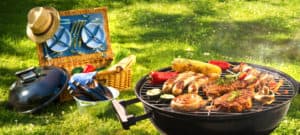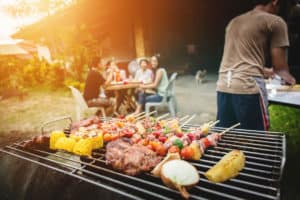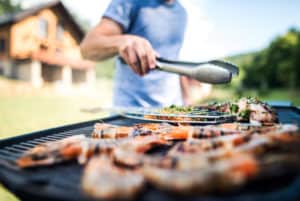
Looking for some charcoal tips? Firing up the backyard grill means brushing up on the latest grilling tips and tricks. So I put together a list to help you level up your grilling game from last year. With these tips, your friends and family will be asking when is your next BBQ.
Those new to the grilling game may find grilling with charcoal a bit more complicated than using an electric or a gas grill, but we’ve got you covered! Here are a few tips to get the ball rolling. With these tips, soon you will be grilling like a grill master.
Compared to fried food grilling involves fewer calories and fat. You can eat your way to health when you use a grill. Grilled food can help with high blood pressure, obesity and other health risks. These tips will not only make your food taste better but they’ll also make grilling easier and you’ll have more fun doing it.
Tips To Make You a Better Griller
1. Add Wood Chips To Your Charcoal
Believe it or not, a fire was once the main requirement for cooking food. The wood you used to make the fire gave meat its flavor, adding a smoky, sweet characteristic to your steak. Fast forward to right now, where gas or electric stoves are the rules rather than the exception.
However, smoking and cooking meat using wood chips never really became outdated and for good reason. There is just no other way to get that wonderful, juicy, smoky flavor that comes from using wood chips. In the grilling world, not all types of wood are created equal. Adding wood chips to your charcoal makes a world of difference.
Hardwood that includes nut wood and fruitwood is ideal due to the structure of the cells. On the other side of the coin are softwoods like cypress, redwood, hemlock, fir, spruce or pine. These are not ideal for cooking meat on a grill because they burn faster, are more pungent and have more sap.
When you use wood chips with your charcoal for flavor enhancement, onlookers would most likely consider you an expert rather than a novice charcoal griller. Whether you are doing a real low-temp barbecue fully smoking meats, or just want to add some of the smoky flavorings to the food you are grilling, the key really is wood.
Fruit woods like cherry and apple as well as mesquite and hickory are some of the usual top choices, according to grill experts. Mesquite and hickory are also great for any occasion where the family is gathered around the grill. If you want to learn more about using wood on with your charcoal you can click here to read my article on it.
2. Dealing With Flare Up’s
Frequent grillers understand the likelihood of flare up’s on a grill each and every time the grill is ready. They know that flames can start small and can begin creeping up on you like a forest fire. When there is too much carbon and grease on the grill this can turn into a serious grease fire, so take this tip seriously.
Generally, fat dripping from your burgers or steak to the hot charcoal doesn’t cause a problem. On the other hand, when dripping fat ignites old grease that has built up around the grill over time, this can become a serious grease fire that will need to be dealt with separately. Obviously, this is something you want to avoid at all costs.
Rather than using a spray bottle of water to deal with flare up’s, which can also blow ashes on the meat. All you have to do is to move the item that is dripping off the direct heat zone and to the indirect cooking zone. Think about it, how could there be any flare up’s when there is no charcoal directly beneath the food?
Flare up’s are characterized as when flames do not go away even when you put out the coals and close the lid. These are higher flames that produce black soot and lots of smoke. Flare up’s are the rapidly-spreading fire that burns within your grill, caused by dripping fat.
The fact is, the burger or steak you happen to be grilling will inevitably have fat dripping on the coals, which cause flare up’s. Other causes can be carbon and grease that have built up on parts of the grill and the grates.
At very high temperatures fatty meat such as chicken, bacon, rib eye, burgers with fat attached and even from oil marinated you use for the meat can catch fire. It might not be a bad idea to have a small fire extinguisher nearby just in case.
3. Separate Zones–The Hot And Cold Of It

Grilling really boils down to two methods, indirect or direct. These let you do specific types of grilling depending on the type of food rather than the volume or thickness. The simplest, most basic method of cooking is through grilling directly. Food is grilled directly on the heat in the simplest way possible. Direct heat can be done without the lid, which is when it’s called grilling. Or you can close the lid, which is more like baking. When you close the lid on food over direct heat, the food gets cooked all over.
Indirect grilling is more similar to baking than grilling. The reason is that indirect grilling with no charcoal under your food allows radiant or convection heat to do the cooking. There is no direct heat involved. The indirect methods evenly cook food, but it will also do this more slowly. Cuts of meat more than two inches thick, roasts and poultry cook best over indirect heat. The reason is that direct heat will cook the outer portion of the meat but leave the inner portions still uncooked due to how hot it is.
Knowing the difference between indirect and direct heat take your dishes further up the expert ladder. Coals produce a specific temperature to help cook food but having the option of cooking with indirect heat is always a good idea when it comes to grilling. The best thing you can do when grilling is to set your grill up for two zone cooking.
Two-zone cooking is the most versatile way to grill. For cooking most of your grilled food, a fire with two-zones should be your first option. To create this type of fire with two different zones, arrange coals on the grill on one side for high-heat, direct cooking and leave the other side of the grill empty.
A two-zone fire is something that master grillers do. This is a fire that has regular charcoal burning normally on one side and an indirect, non-charcoal area on the other side. In other words, you would have a hot zone and a cool zone, also known as a direct heat area and an indirect heat area.
The cooler zone helps prevent scorched, overheated food from happening and the hot zone turns raw food into cooked food. You can then transfer the hot food to the cool zone when it is cooked and needs a bit more cooking using indirect heat.
The side with no coals can be used for cooking with lower temperatures as a flare-up safe zone. Think of it as having a zone for searing and one for roasting. You can now cook your food on the zone which is appropriate. For instance, sear a steak in the hot zone to get grill marks, caramelization, and good color. The other side can be for slow cooking.
Building a fire with two zones is something that many grilling experts recommend. It’s an easy technique but learning how to do this gets you much farther in terms of your food repertoire compared to building just a one-zone fire.
4. Vent Control!
Closing and opening the grill vents controls the oxygen flow. You can control the temperature of coals on the grill through learning how to use the vents. On a charcoal grill, a dial simply does not exist. However, you do need to adjust the heat from low to high sometimes. The way to do this is to control the oxygen flow in such a way that controls how hot the charcoal on the grill gets.
Grilling food is really about heat control. Whether you have an indoor or outdoor grill, if you are cooking with pure wood or charcoal with wood chips, you will need to control and understand how the vents work on your grill. Remember, a charcoal grill has two kinds of fuel, the wood or charcoal, plus the oxygen. This enables you to control the oxygen and in doing so control the temperature.
There are two controls for oxygen on most grills. One is an intake feature that oxygenates the fire and another one is the vent that pulls in oxygen and exhausts the gasses. The job is to either lessen or increase the flame. Close the vent and you starve the fire, which burns exclusively on oxygen. Oxygen is slowed by trimming the vents, which causes the grill to cool. Don’t close the vents all the way, however, as this will extinguish the fire.
Open the vent and you feed the fire. Practicing how to use the vents before actual food is in the picture, particularly if you are a new grill owner, is essential. Open vents let more air in, and this gets your grill hotter.
Make sure that your vents are unobstructed by removing the ashes. You will need to clear the vent precisely to control the flow of oxygen.
5. Oiling Your Grates
Before you get your grill-grates oiled, it is a good idea to use a grilling brush to sweep away all particles of food left from the last barbecue. Use a nylon grill brush to allow you to sweep the grates even while the grill is still hot. Just start brushing every grate until there is no longer any food. You can then go on to the next step of oiling the grates once this step is done.
When you oil your grates it helps keep food from sticking to them. So you can flip your burgers with ease, even to the tune of your favorite background music!
To oil, your grates, dip a crumpled paper towel into peanut, olive or canola oil. Don’t overly saturate the towel. You want minimal dripping and a light coat over every grate. Use tongs or a silicon oven mitten to wipe the grates with the oiled paper towel.
Of course, you can also oil a cold grate with the peanut oil, olive oil or canola oil. Oil every grate and get rid of the excessive oil with another paper towel. Get your grill lit after you do this and keep the heat on until you see the oil burning off or smoking off your grill. For best cooking results, oil your grates after every use, as well as just before you use it. If you’d like to learn more about seasoning (Oiling) your grill grates you can click here to read my full article on it.
Some cast-iron grill grates are coated in porcelain to make them rust-proof. If you have porcelain-coated cast iron or a new grill with stainless steel grates, make sure you preheat the brand new grates to get rid of any residues left behind from the manufacturing process.
6. Preheating Is Everything
Your food won’t stick to the grill when you preheat and oil the cooking grates. When cooking on a cold grate, for example, steaks tend to become overcooked and end up sticking to the grill like a hot mess. Plus, a cold grill does not get you lovely grill markings. It is also safer to oil your grate before setting it over the hottest charcoal.
When you have a gorgeous piece of salmon on your grill and you go to attempt to flip it over gently lifting it off the grill. But it stubbornly sticks to the grate. Ending in a tug-o-war between you and the cooked salmon except you lose and the salmon wins.
This can only be prevented by oiling a clean grill before and after every use. When you do this, you will be able to easily flip food around like a seasoned burger-flipper, and this includes salmon burgers and even salmon fillets. Plus, a clean grill always results in grilled marks that just look so appetizing.
7. Don’t Use To Much Charcoal

Using the correct amount of charcoal is going to make a difference in how your food turns out. The amount of charcoal will determine the temperature your grill becomes. Different food will require different temperature settings. Meat requires a different setting than seafood and vegetables, for example. Knowing how to easily figure out temperature based on the amount of charcoal you have can even save you from having to use a thermometer! Of course, if your grill has a built in thermometer, then you get twice the accuracy for everything.
Are you already comfortable using a chimney starter? If yes, everything will simply start falling into place, particularly with using the right amount of charcoal. Smoking, larger roasts, whole poultry, and pork ribs are best done at 225F temperature which is low heat and this is a quarter of a chimney. Also, this is best done with indirect heat over a few hours.
Seafood, veggies, and pieces of chicken will require medium heat and you can get this by filling the chimney half full of coals. Grilling thin cuts of meats and steaks at high heat is ideal and it will require a full chimney to reach this temperature. So the way you fill up a chimney will determine the cooking temperature you end up with. Which will, in turn, cook the corresponding types of food.
8. What Is Your Recipe “Baste” On?
It doesn’t take an expert to baste at the right time. Knowing a few basic guidelines to keep in mind will suffice. Basting at the wrong time will give you corresponding unwanted results, to say the least. The time to baste will depend on what kind of basting sauce you are using at the moment. Marinades and bastes that are made with yogurt, citrus, oil or vinegar can be brushed on the slabs you are grilling during the time you are cooking.
Remember not using the same marinade you used for raw food. It is important that you use a new batch of the same marinade. It might be tempting to just use the marinade the food was sitting in. But there’s now raw juices from the meat in the marinade. If you were to use it and it didn’t cook long enough to kill bacteria that may have been in it, it can make you very sick.
Using barbecue sauce that contains sugar needs to be applied towards the end of your time cooking. Prolonged heat tends to cause sugar to burn and if you apply your barbecue sauce in the beginning, the sugar turns into a black charred mess after a while. Knowing these basic hard and fast rules with regards to raw marinade and sugar-based marinades make a big difference in your results. If you like to learn more about marinades and dry rubs you can click here for my full article on it.
9. Using Chimney Starters
Using a chimney starter should be a requirement for grilling with charcoal. These get charcoal ready in just fifteen to twenty minutes. Some chimney starters are able to light up to a hundred briquettes of charcoal at a time. All you need is a sheet of newspaper and a match. There won’t be a need for lighter fluid any longer! This means you will no longer have to suffer through chemical taste on your steaks. The six-quart chimney starters are recommended for new grilling hobbyists and you can find these in home stores or hardware stores everywhere.
To use a chimney starter, you will first need to remove the grill grates. Next, fill up your chimney starter with as much or as little charcoal as you will need. You then need to ball up your sheet of paper and place it on the charcoal grate. Set your chimney starter over it and use your match to light the paper through one of the holes in the bottom of the chimney starter.
The fire will begin to burn the charcoal and the flame will grow on its own. After fifteen minutes, the charcoal will be ready. You will see it getting white ash over it. This is when you pour the charcoal on the grate and arrange them depending on where you want your indirect and your direct heat.
Once you’ve poured out the charcoal from the chimney starter, make sure you put it in a safe place as it will be hot and kids could be anywhere around you. Once you have arranged the charcoals, it will take another fifteen minutes to reach the correct temperature for grilling. This is when your grill is at the pre-heated stage.
Do you see why this is called a chimney starter? The reason is that the heat travels up it like smoke going out a chimney. This causes the charcoal to light faster then if they were just in a pile on the charcoal grates. Chimney starters are by far the fastest way to get everything going. If you have lighter cubes you can use them in place of the paper. Just set the lighter cube on the charcoal grate and light it. Then set the chimney starter on the charcoal grate on top of the lit lighter cubes. For more Tips on lighting charcoal grills, you can click here to read my full article
10. Consider Using A Grill Basket
When it comes to tips this one will keep your food on the grill and not on the charcoal. This is the tip to remember. Food can fall through the grates of your grill especially if you are grilling fruits, tofu, fish and vegetables. Consider using a grill basket to save your food and to do less cumbersome work flipping, turning, tossing and lifting out each vegetable from the grill.
With a grill basket, you do one job that and one removal with a lot of food done. There won’t be a need to pick out the chopped grilled eggplant one slice at a time. you won’t have to try and pick up one cherry tomato at a time with a skewer once all fifty of them are cooked.
Also, you can take the basket from the sink and into the grill. You can chop and prep all your vegetables and tofu, wash them, lay them on the basket and put the basket on the grill. Baste them with olive oil and salt as if they were not in the basket. In fact, treat the contents of the basket as if they were right on the grill.
To turn the food, just give the basket a little shake and the food inside the basket won’t need to be turned one single piece at a time. Turning the food by shaking the basket a bit to get the cooked sides up and the uncooked sides down will evenly cook the veggies without a lot of hassle. Check to see if the veggies and even the tofu are all cooked. Remove the entire basket and put this on a cooling rack. You can enjoy a grilled vegetable salad with very little fuss at all.
11. Safety Is A Must

You are going to be working with a lot of fire, hot coals, heated surfaces and be near the flame. It is a good idea to keep your hair away from the source of heat and not wear an apron that has tons of ribbons or pockets. The reason is you never know when the next flare-up is going to occur.
For this reason, having as little flammable items near the flame that can get scorched is highly advisable. Plus, for extra safety, have a bucket of water or a fire extinguisher nearby at all times. After all, you are playing with fire. That is, you are cooking using charcoal and fire and that could feel very comfortable after a while. But taking the right precautions and always have a way to put an out of control fire out is always a good idea.
Conclusion
Grilling can be the best memory you make this summer. With these tips, you’ll not only have more fun when grilling, but all your friends and family will be amazed at how well you know how to use the grill. I won’t be surprised if next time they have you over for a cookout if they ask you for a few tips or to help them out with the grill. They might even just ask if you just want to do the grilling sins your better on the grill.
As Always, Happy Grilling!
